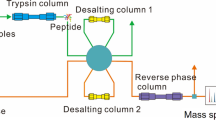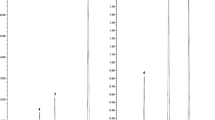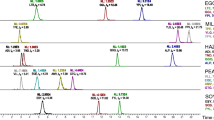Abstract
The aim of this work was the determination of peptides, which can function as markers for identification of milk allergens in food samples. Emphasis was placed on two casein proteins (α- and β-casein) and two whey proteins (α-lactalbumin and β-lactoglobulin). In silico tryptic digestion provided preliminary information about the expected peptides. After tryptic digestion of four milk allergens, the analytical data obtained by combination of reversed-phase high performance liquid chromatography and quadrupole tandem mass spectrometry (LC-MS/MS) led to the identification of 26 peptides. Seven of these peptides were synthesized and used for calibration of the LC-MS/MS system. Species specificity of the selected peptides was sought by BLAST search. Among the selected peptides, only LIVTQTMK from β-lactoglobulin (m/z 467.6, charge 2+) was found to be cow milk specific and could function as a marker. Two other peptides, FFVAPFPEVFGK from α-casein (m/z 693.3, charge 2+) and GPFPIIV from β-casein (m/z 742.5, charge 1+), occur in water buffalo milk too. The other four peptides appear in the milk of other species also and can be used as markers for ruminant species milk. Using these seven peptides, a multianalyte MS-based method was developed. For the establishment of the method, it was applied at first to different dairy samples, and then to chocolate and blank samples, and the peptides could be determined down to 1 ng/mL in food samples. At the end, spiked samples were measured, where the target peptides could be detected with a high recovery (over 50%).

Possible marker peptides from four milk allergens for the detection of ruminant milk proteins



Similar content being viewed by others
References
Wal JM (2004) Bovine milk allergenicity. Ann Allergy Asthma Immunol 93(5 Suppl):S2–S11
Weber D, Raymond P, Ben-Rejeb S, Lau B (2006) Development of a liquid chromatography-tandem mass spectrometry method using capillary liquid chromatography and nanoelectrospray ionization-quadrupole time-of-flight hybrid mass spectrometer for the detection of milk allergens. J Agric Food Chem 54(5):1604–1610
Chatchatee P, Järvinen KM, Bardina L, Vila L, Beyer K, Sampson HA (2001) Identification of IgE and IgG binding epitopes on β- and κ-casein in cow's milk allergic patients. Clin Exp Allergy 31(8):1256–1262
Monaci L, Tregoat V, van Hengel AJ, Anklam E (2006) Milk allergens, their characteristics and their detection in food: a review. Eur Food Res Technol 223(2):149–179
Sélo I, Clément G, Bernard H, Chatel JM, Créminon C, Peltre G, Wal JM (1999) Allergy to bovine β-lactoglobulin: specificity of human IgE to tryptic peptides. Clin Exp Allergy 29(8):1055–1063
Wal JM (2001) Structure and function of milk allergens. Eur J Allergy Clin Immunol 56(67 Suppl):35–38
Monaci L, van Hengel AJ (2008) Development of a method for the quantitation of whey allergen traces in mixed-fruit juices based on liquid chromatography with mass spectrometric detection. J Chromatogr A 1192(1):113–120
Blanc F, Bernard H, Alessandri S, Bublin M, Paty E, Leung SA, Patient KA, Wal JM (2008) Update on optimized purification and characterization of natural milk allergens. Mol Nutr Food Res 52(suppl 2):S166–S175
Poms RE, Klein CL, Anklam E (2004) Methods for allergen analysis in food: a review. Food Addit Contam 21(1):1–31
Monaci L, Visconti A (2009) Mass spectrometry-based proteomics methods for analysis of food allergens. TrAC, Trends Anal Chem 28(5):581–591
van Hengel AJ (2007) Food allergen detection methods and the challenge to protect food-allergic consumers. Anal Bioanal Chem 389(1):111–118
Léonil J, Gagnaire V, Mollé D, Pezennec S, Bouhallab S (2000) Application of chromatography and mass spectrometry to the characterization of food proteins and derived peptides. J Chromatogr A 881(1–2):1–21
Wehr T (2006) Top-down versus bottom-up approaches in proteomics. LC GC N Am 24(9):1004–1010
Trujillo AJ, Casals I, Guamis B (2000) Analysis of major ovine milk proteins by reversed-phase high-performance liquid chromatography and flow injection analysis with electrospray ionization mass spectrometry. J Chromatogr A 870(1–2):371–380
Hau J, Bovetto L (2001) Characterisation of modified whey protein in milk ingredients by liquid chromatography coupled to electrospray ionisation mass spectrometry. J Chromatogr A 926(1):105–112
Cocco RR, Järvinen KM, Sampson HA, Beyer K (2003) Mutational analysis of major, sequential IgE-binding epitopes in αs1-casein, a major cow's milk allergen. J Allergy Clin Immunol 112(2):433–437
Fenaille F, Parisod V, Tabet J-C, Guy PA (2005) Carbonylation of milk powder proteins as a consequence of processing conditions. Proteomics 5:3097–3104
Monaci L, Losito I, Palmisano F, Visconti A (2010) Identification of allergenic milk proteins markers in fined white wines by capillary liquid chromatography—electrospray ionization-tandem mass spectrometry. J Chromatogr A 1217(26):4300–4305
Monaci L, Nørgaard JV, van Hengel AJ (2010) Feasibility of a capillary LC/ESI-Q-TOF MS method for the detection of milk allergens in an incurred model food matrix. Anal Methods 2(7):967–972
In-solution digestion. Available at http://www.osa.sunysb.edu/Proteomics/ProteinDigestPrep.pdf. Accessed 14 Jan 2008
PeptideMass. Available at http://www.expasy.org/tools/peptide-mass.html. First accessed 20 Sept 2008
PFIA. Available at http://hodgkin.mbu.iisc.ernet.in/~pfia/. First accessed 30 Nov 2008
BLAST. Available at http://blast.ncbi.nlm.nih.gov/Blast.cgi. First accessed 28 Oct 2008
Acknowledgements
The authors thank the Christian Doppler Research Association and RomerLabs for funding the Christian Doppler Laboratory ‘Rapid Test Systems for Allergenic Food Contaminants’. We thank also the government of Lower Austria for financial supporting of this work.
Author information
Authors and Affiliations
Corresponding author
Rights and permissions
About this article
Cite this article
Ansari, P., Stoppacher, N., Rudolf, J. et al. Selection of possible marker peptides for the detection of major ruminant milk proteins in food by liquid chromatography-tandem mass spectrometry. Anal Bioanal Chem 399, 1105–1115 (2011). https://doi.org/10.1007/s00216-010-4422-0
Received:
Revised:
Accepted:
Published:
Issue Date:
DOI: https://doi.org/10.1007/s00216-010-4422-0




